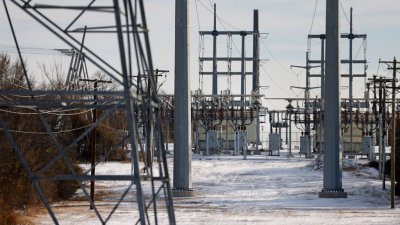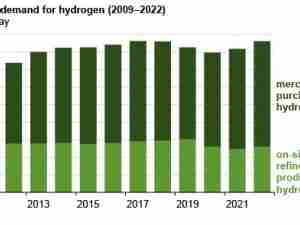The biggest test of Texas’s newly fortified power grid will arrive around sunrise Friday, when electricity demand may set a record as waking residents crank up their heaters in the sub-freezing cold.
The state’s electrical system, which collapsed nearly a year ago during a brutal cold snap and left more than 200 people dead, is expected to pass the trial. But success isn’t guaranteed. Critics have warned for months that grid managers and utilities haven’t done enough to winterize the system, while Governor Greg Abbott and other politicians have tried to reassure Texans the state is ready.
Outages struck only a few pockets of the sprawling state by early Friday. Natural gas has continued to flow through the pipelines that feed many of the state’s power plants, with limited disruptions. And wind turbines, whose poor performance during last year’s deep freeze has become the focus of Abbott’s scorn, supplied far more power than expected, keeping electric heaters humming.
Sub-freezing temperatures dipped further overnight and were expected to reach their lows around dawn. The Electric Reliability Council of Texas, which runs the power grid, said electricity demand could set a winter record of 73.5 gigawatts, close to the state’s summer high of 74.8 gigawatts. Typically, a gigawatt is enough to power about 200,000 Texas homes.

Abbott said Thursday the system was prepared. “The Texas power grid is the most reliable and resilient it’s ever been,” he said at a press conference.
About 15,000 homes and businesses were without power by about 4:30 a.m. local time Friday, down from more than 30,000 late Thursday, according to PowerOutage.us, which tracks outages reported on utility websites.
“These are localized outages that are not related to system-wide reliability issues,” Peter Lake, chairman of the Public Utility Commission of Texas, said earlier at a media briefing. “The grid remains strong, reliable, and it is performing well in this winter-weather event.”
Texas has been bracing for the worst in this latest storm, which is part of a massive cold front that stretches to Maine. Many schools, universities, and churches have closed, while grocery stores have been left depleted as residents stocked up on food. Even sea turtles off the Texas coast are under threat from the cold.
Temperatures in the Panhandle region fell to about zero degrees (-18 Celsius) early Friday, while Dallas was at 21 degrees, according to the U.S. National Weather Service. However, the storm is moving through fairly quickly, and temperatures are set to rise this weekend. That would be a key difference from last year’s storm, which lingered for days.
“It’s obviously quite cold, but the duration of that cold won’t be very long,” said William Iwasko, a meteorologist with the weather service’s Lubbock office.
Some natural gas wells have frozen in Texas and neighboring Oklahoma, shutting about 5% of overall domestic output during the peak demand season for the furnace and power-plant fuel, according to Jade Patterson, an analyst at BloombergNEF. The interruptions will take as long as five days to restore once temperatures moderate, he said.
Meanwhile, the wind has provided an unexpected benefit to the state’s electrical grid, according to Ercot. On Thursday morning, wind accounted for about 30% of the grid’s electricity supply.
“We expected significant icing in the western part of the state,” Ercot Interim Chief Executive Officer Brad Jones said in the briefing. “That has not occurred as severely as expected.”








